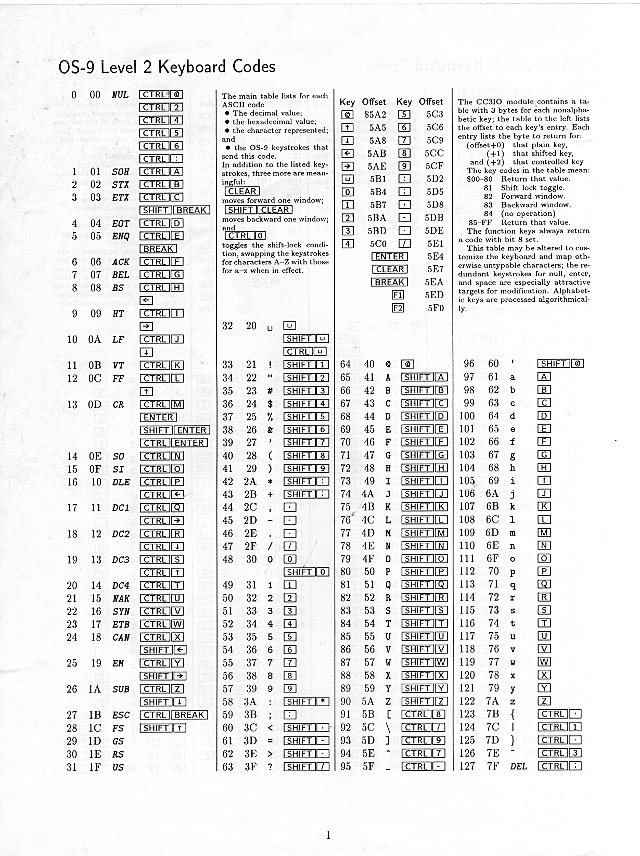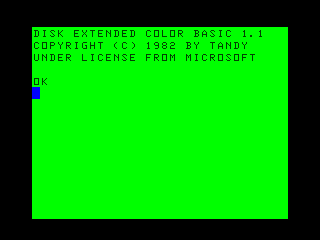
The Color Computer keyboard included a big red “Break” key (photos from the Wikipedia entry)
| Date: | 25 February 2013 |
|---|---|
| Tags: | computing |
I designed and printed this chart long ago. It has now been haunting my desk drawer for more than twenty years. I have kept it because of nostalgia — not from any real likelihood of needing it again — and should post it here online on the slender chance that it might someday be useful to someone else:

It is a chart of every ASCII character that it is possible to type on the keyboard of a Radio Shack Color Computer running the OS-9 operating system. Apparently I was a very thorough teenager. Did I really needed a complete reference sheet like this? Or was it a convenient excuse to play with graphic design and format a complicated document with Knuth's TeX typesetting system?
The Color Computer's keyboard was severely limited. You would never guess, at a first glance, that it could in fact support the entire ASCII printable character set, but the OS-9 operating system heaped key combinations atop each other until the chart was filled.

The Color Computer keyboard included a big red “Break” key (photos from the Wikipedia entry)
But the keyboard under OS-9 cannot be used to type the characters Group Separator, Record Separator, or Unit Separator. This was an important omission, because Group Separator — also known as ^] or control-right-bracket — is how you shut down a hung Telnet session when talking to a Unix machine over a modem. So the upper-right corner of my chart includes instructions for how to patch the operating system at runtime to add extra characters to the keyboard map!
Note that this was not Mac OS 9, for which Steve Jobs held a funeral, but OS-9 with a real honest hyphen, from the wild 1970s and 1980s when punctuation was flung so freely and extravagantly into the names of computers, programming languages, and operating systems.

With the investment of several hundred more dollars, the Color Computer's cartridge slot could be expanded to support several drives, printers, and serial lines.
The web suggests that one vendor still supports OS-9 — though probably not on the 8-bit Motorola 6809 processor where I once ran it! My Radio Shack Color Computer 2 did not support hardware memory management, so an operating system could not protect processes from writing into each other's address spaces. But OS-9 did provide real preëmptive multitasking that let me switch between multiple terminals and shells all running at the same time — quite a feat on a machine whose 16-bit address registers supported a maximum of only 64k of memory.
In retrospect, I should have spent more time with Basic09, OS-9's structured interpreted dynamic language that enforced consistent indentation and compiled to bytecode — features that I now enjoy every day in Python. But I was a programming language conservative back then, and was more comfortable sticking with “official” languages: the awkward Microsoft Basic that came built-in to the Color Computer, and C, the Korn shell, and awk when using my father's Unix machine.

The screen that has greeted me ten thousand times.
My OS-9 keyboard chart seems to now exist as only a single copy, from which I scanned the PDF above. I apologize for the ghosting — it appears that I printed it, corrected a few mistakes in pencil, then turned the sheet of paper over to print the final version, resulting in the first printout of the chart showing faintly through from the other side of the paper.
Whenever I am tempted to dissuade a young programmer from installing Arch Linux and burning a week of their life learning how thumb drives auto-mount when plugged into USB, I stop myself, think back, and remember those days long ago when I would track down the particular byte in memory that could be patched to let me type exactly the character code that I needed.